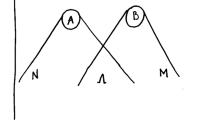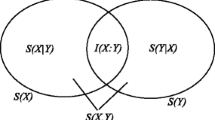Abstract
We use a simple relational framework to develop the key notions and results on hidden variables and non-locality. The extensive literature on these topics in the foundations of quantum mechanics is couched in terms of probabilistic models, and properties such as locality and no-signalling are formulated probabilistically. We show that to a remarkable extent, the main structure of the theory, through the major No-Go theorems and beyond, survives intact under the replacement of probability distributions by mere relations.
Similar content being viewed by others
References
Abramsky, S., and A. Brandenburger, The sheaf-theoretic structure of nonlocality and contextuality, Arxiv preprint arXiv:1102.0264, 2011.
Barendregt, H. P., Lambda calculi with types, in S. Abramsky, D. Gabbay, and T. Maibaum, (eds.), Handbook of logic in computer science, vol. 2, Oxford University Press, 1992, pp. 117–309.
Barrett J., Linden N., Massar S., Pironio S., Popescu S., Roberts D. (2005) Nonlocal correlations as an information-theoretic resource. Physical Review A 71(2): 22101
Bell J. S. (1964) On the Einstein-Podolsky-Rosen paradox. Physics 1(3): 195–200
Brandenburger, A., and H. J. Keisler, Observable implications of unobservable variables, 2010. Available at http://pages.stern.nyu.edu/abranden/oiuv-06-22-10.pdf.
Brandenburger A., Yanofsky N (2008) A classification of hidden-variable properties. Journal of Physics A: Mathematical and Theoretical 41: 425302
Cabello A., Estebaranz J.M., García-Alcaine G. (1996) Bell-Kochen-Specker theorem: A proof with 18 vectors. Physics Letters A 212(4): 183–187
Canny, J., Some algebraic and geometric computations in PSPACE, in Proceedings of the twentieth annual ACM symposium on Theory of computing, ACM, 1988, pp. 460– 469.
Clauser J.F., Horne M.A., Shimony A., Holt R.A. (1969) Proposed experiment to test local hidden-variable theories. Physical Review Letters 23(15): 880–884
Dickson, W. M., Quantum chance and non-locality, Cambridge University Press, 1999.
Dubois, D., J. Lang, and H. Prade, Possibilistic logic, in D. Gabbay and C. J. Hogger, (eds.), Handbook of logic in artificial intelligence and logic programming: nonmonotonic reasoning and uncertain reasoning, vol. 3, Oxford University Press, 1994, pp. 439–513.
Einstein A., Podolsky B., Rosen N. (1935) Can quantum-mechanical description of physical reality be considered complete?, Physical Review 47(10): 777–780
Fine A. (1982) Hidden variables, joint probability, and the Bell inequalities. Physical Review Letters 48(5): 291–295
Fritz, T., Possibilistic Physics, FXQi essay, available at http://www.fqxi.org/community/forum/topic/569, 2009.
Fritz, T., Quantum analogues of Hardy’s nonlocality paradox, Arxiv preprint arXiv:1006.2497, 2010.
Ghirardi, G. C., A. Rimini, and T. Weber, A general argument against superluminal transmission through the quantum mechanical measurement process, Lettere Al Nuovo Cimento (1971–1985) 27(10):293–298, 1980.
Greenberger D.M., Horne M.A., Shimony A., Zeilinger A. (1990) Bell’s theorem without inequalities. American Journal of Physics 58: 1131
Hardy L. (1993) Nonlocality for two particles without inequalities for almost all entangled states. Physical Review Letters 71(11): 1665–1668
Jarrett J.P. (1984) On the physical significance of the locality conditions in the Bell arguments. Noûs 18(4): 569–589
Jordan T.F. (1983) Quantum correlations do not transmit signals. Physics Letters A 94(6-7): 264
Kennedy J.B. (1995) On the empirical foundations of the quantum no-signalling proofs. Philosophy of Science 62(4): 543–560
Khalfin L.A., Tsirelson B.S. (1992) Quantum/classical correspondence in the light of Bell’s inequalities. Foundations of physics 22(7): 879–948
Kochen S., Specker E.P. (1967) The problem of hidden variables in quantum mechanics. Journal of Mathematics and Mechanics 17(1): 59–87
Libkin, L., Elements of finite model theory, Springer Verlag, 2004.
Mermin N.D. (1990) Quantum mysteries revisited. American Journal of Physics 58(8): 731–734
Mermin N.D. (1990) Simple unified form for the major no-hidden-variables theorems. Physical Review Letters 65(27): 3373–3376
Mermin N.D. (1994) Quantum mysteries refined. American Journal of Physics 62: 880
Nielsen, M. Q. C., and I. Chuang, Quantum Computation and Quantum Information, Cambridge University Press, 2000.
Pitowsky, I., Quantum Probability, Quantum Logic, vol. 321 of Lecture Notes in Physics, Springer, 1989.
Popescu S., Rohrlich D. (1994) Quantum nonlocality as an axiom. Foundations of Physics 24(3): 379–385
Renegar, J., On the computational complexity and geometry of the first-order theory of the reals. Part I: Introduction. Preliminaries. The geometry of semi-algebraic sets. The decision problem for the existential theory of the reals, Journal of Symbolic Computation 13(3):255–299, 1992.
Shimony, A., Events and processes in the quantum world, in R. Penrose and C. J. Isham, (eds.), Quantum concepts in space and time, Oxford University Press, 1986, pp. 182–203.
Tarski, A., A decision method for elementary algebra and geometry: prepared for publication with the assistance of J. C. C. McKinsey, Tech. rep., Rand Corporation, 1951.
Tsirelson B.S. (1980) Quantum generalizations of Bell’s Inequality. Letters in Mathematical Physics 4: 93–100
Author information
Authors and Affiliations
Corresponding author
Rights and permissions
About this article
Cite this article
Abramsky, S. Relational Hidden Variables and Non-Locality. Stud Logica 101, 411–452 (2013). https://doi.org/10.1007/s11225-013-9477-4
Published:
Issue Date:
DOI: https://doi.org/10.1007/s11225-013-9477-4




